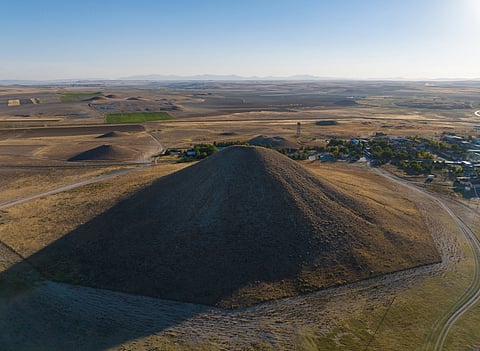
- Destinations
- Experiences
- Stay
- What's new
- Celebrating People
- Responsible Tourism
- CampaignsCampaigns
- Subscribe
- Buy Now

In exciting news this week that made headlines around the world, archaeologists in Türkiye discovered a well-preserved wooden burial chamber near the capital Ankara that ostensibly belonged to a high-ranking member of a Phrygian royal family. The site, designated as Tumulus 26 (T26), dates back to the eighth century BCE, a period known for its rich cultural and historical significance in Phrygian society.
In fact, the capital city of the civilisation of Phrygia, Gordion, is said to have been ruled by the legendary King Midas, who Greek mythology tells us had “a golden touch,” where everything he touched turned to gold.
A UNESCO World Heritage Site since 2023, Gordion also lives on in the English language because of the term “cut the Gordian Knot,” which means an intricate problem that has been resolved after insurmountable difficulty. The phrase originates with Gordios, Midas’ father and the founder of Gordion, who created a knot whose untying would allow the person to conquer and rule Asia. Centuries later, when Alexander the Great arrived, he sliced the knot in half with his sword and gained a new kingdom.
In this article, we explore Phrygian civilisation and why Gordion should be one of the stops on your Türkiye itinerary.
The Iron Age kingdom of Phrygia flourished between the ninth and eighth centuries BCE. Ancient Greek historians say that the Phrygians migrated to Anatolia from the Balkans, settling in a large area that now encompasses the Ankara, Afyonkarahisar, Eskişehir and Kütahya provinces of present-day Türkiye.
The people spoke Phrygian, a language similar to Greek and Armenian and not at all like the Anatolian languages spoken by most of their neighbours. According to the “Iliad,” the Phrygians participated in the Trojan War as close allies of the Trojans.
The Phrygian religion was polytheistic and distinct from the earlier religions of the Anatolian people. Their main deity was Matar Kubeleya, a goddess associated with mountains and wild animals.
The Phrygian State collapsed in the early seventh century BCE following the attacks of nomadic Cimmerians who sacked all of Anatolia. However, the Iron Age community was not completely erased from history. Members of its royal family, who survived the attacks, continued their existence in various parts of Anatolia, conserving their culture and traditions.
Today, the Mountainous Phrygia region, which encompasses nearly 52 hectares in area, has several important archaeological sites that display traces of the Phrygians’ rituals and social life.
Gordion stood at the intersection of the major east-west trade routes during the Phrygian civilisation: the empires of Assyria, Babylon and the Hittites were to the east, and to the west were Greece and Lydia. The Phrygians were able to take advantage of this strategic location and became wealthy and powerful.
Today, more than 150 burial mounds, or tumuli, encircle Gordion, dating from the ninth to the sixth centuries BCE. These giant earthworks were built to protect the tombs of important people from grave robbers, much like the Egyptian pyramids.
The main settlement mound lies on the Sakarya River in the village territory of Yassıhöyük. The largest tumuli in the area, a steep-sided peak now carpeted in scrubby yellow grass, stands 53m high, making it the second largest burial mound in Türkiye. Experts estimate it took 1,000 people up to two years to build it.
In 1957, experts carefully tunnelled into the mound, nicknamed the “Midas Mound.” They found a large burial chamber constructed from pine and juniper logs, perfectly preserved inside its airtight cocoon for nearly 3,000 years.
Visitors can follow that same excavation tunnel deep into the mound to visit the tomb—the oldest wooden building still standing anywhere in the world. Because of its fragility, it is supported by girders and protected by a metal fence.
Besides this, history buffs will also be able to see the marvellous excavated pieces at the Gordion Museum. Among the artefacts on display are handmade pottery from the Early Iron Age, iron tools from the Early Phrygian period, seal and coin samples, and ancient pottery and imported goods.
One of the best ways to get a feel for the region's history is by hiking the Phrygian Way, Türkiye’s third-longest hiking trail which stretches more than 500 km across the provinces of Ankara, Afyonkarahisar, Kütahya, Eskişehir, Uşak, and Burdur.
On the route you will find geologically interesting formations like fairy chimneys and historic sites with rock-cut dwellings, rock-cut tombs, temples, churches and settlements from Phrygia, the Roman Empire, the Byzantine Empire, the Seljuk Empire and the Ottoman Empire.
While summer is a popular time for tourists to visit Türkiye, the best time to visit is during the spring (March to May) and autumn (September to early November) because of the pleasant temperatures.
Take a flight to Ankara Esenboğa Airport (ESB) from India via Doha, Istanbul or any other connecting airport. Gordion is 96 km from Ankara, which you can reach via bus or taxi.
